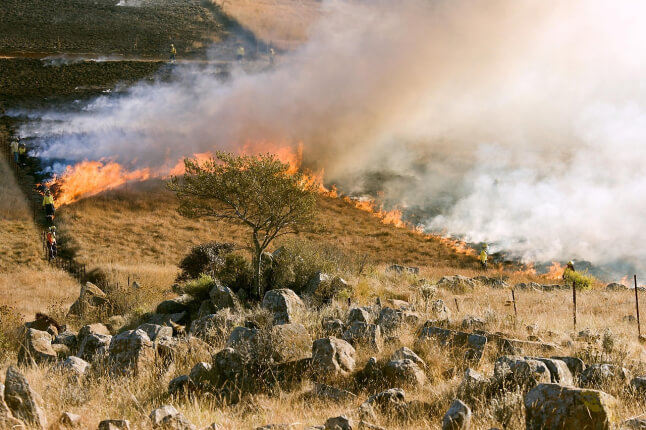News
Daniel Jacob, Vasco McCoy Family Professor of Atmospheric Chemistry and Environmental Engineering (Mohamed Maher/AP Images)
Carbon dioxide is the usual villain in the climate change story. Emitted largely through the use of fossil fuels, it not only warms the planet now, but will continue to do so for more than a century while it remains in the atmosphere.
Less well known is the role that another greenhouse gas—methane—plays. About one third of global methane emissions occur naturally, mostly from wetlands. But two-thirds are caused by human activity, including from oil and gas operations, coal mining, landfills, plus livestock and rice paddies. And because of its chemical composition, methane has a much higher global-warming potential than carbon dioxide does—up to 80 times as much—and is responsible for about a third of current global warming. But crucially, methane lingers in the atmosphere for much less time than carbon dioxide does—only about 10–20 years.
“What that means is that methane is responsible more for near-term climate change, but it also means that acting on methane can give us a short-term climate response,” says Daniel Jacob, the Vasco McCoy Family Professor of Atmospheric Chemistry and Environmental Engineering at the Harvard John A. Paulson School of Engineering and Applied Sciences (SEAS). “So, if we are trying to address climate change over the next decade or two, methane is a very powerful lever.”
Jacob and Robert Stavins, the A.J. Meyer Professor of Energy and Economic Development at Harvard Kennedy School and director of the Harvard Environmental Economics Program and the Harvard Project on Climate Agreements, are combining their respective natural sciences and public policy expertise on a project designed to help policymakers use that lever. For countries currently working to address climate change through a variety of international agreements, the Harvard team’s efforts will help policymakers more precisely determine their existing emissions and, from there, their proposed cuts.
“There is increasing recognition that in the shorter term, methane is exceptionally important,” Stavins says. “Now, if you look over a 100-year time horizon, which has been the traditional convention, then methane doesn’t look nearly as important. But you have to recognize that the emissions targets being used and considered right now are not for the year 2100 or 2050, they’re for 2030. And if you’re talking about from now until 2030, methane is incredibly important. That’s why there’s increasing recognition from so many participants in the process of the exceptional importance of methane.”
Funded by the Harvard Climate Change Solutions Fund, which was started by the University in 2014 to support research and policy initiatives battling climate change, the project is using observations from recently deployed satellites to create a clearer picture of precisely where and how methane is being emitted.
2019 TROPOMI satellite observations of atmospheric methane concentrations and emissions for the Middle East and parts of North Africa.
At COP 27, the global climate change summit, which was held in the Egyptian Red Sea resort of Sharm el-Sheikh in November, Jacob and Stavins publicized their work and offered their data to eager global policymakers. Over the coming year, the Harvard team will continue to gather and disseminate more data.
Data on methane emissions has historically been problematic. It was based exclusively on a bottom-up approach, which estimates emissions according to certain activity levels on the ground rather than on actual atmospheric data. So a country would count the head of cattle it has or the number of gas wells or coal mines, and estimate their methane emissions from there.
Jacob’s laboratory at SEAS adds an invaluable layer of top-down information. His team takes data collected by satellites—the two most important ones were launched by Europe and Japan—that orbit the earth and collect data on methane concentrations in the atmosphere. Then, using inventories of methane emissions that countries provide, they calculate backwards to correct those inventories and understand where the emissions actually originated, yielding a near real-time and spatially accurate map of the emissions.
“What we can do uniquely from satellite is look at recent changes in emissions, because the emission inventories that are coming out of individual countries are based on statistics that are typically two or three years old,” Jacob says. “But if we’re going to try to change the emissions rapidly, and to verify those changes in emissions, the only way that I can think of is to do it from satellites.”
Stavins, whose work through the Harvard Project on Climate Agreements has made him an invaluable resource both to the United Nations body overseeing the Paris Agreement and to individual countries’ negotiating teams and NGOs, is working to help disseminate the new data and also receiving input from policymakers and relaying that back to Jacob’s team—indicating what data would be most helpful to particular countries, whether in terms of emissions by sector or geographic region or time scale.
The new, more accurate emissions information comes at a crucial moment as countries work to calculate their greenhouse gas reduction targets in accordance with international agreements and national policies, and as industry groups also work to reduce emissions. Under the Paris Agreement, signatories produce nationally determined contributions (NDCs), which are reduction pledges for pollutants including methane. Under the Global Methane Pledge, coauthored by the United States and the European Union in 2021, 125 countries have now agreed to help reduce aggregate global methane emissions by nearly a third from 2020 levels by 2030. The countries participating in this pledge account for nearly 50% of global anthropogenic methane emissions and about two-thirds of global gross domestic product. If they maintain their pledges that could reduce warming by 0.2 degrees Celsius by 2050. And the Methane Guiding Principles, a voluntary initiative to reduce methane emissions from the natural gas supply chain, was launched in 2017 by some of the world’s largest energy companies, including BP, Shell, ExxonMobil, and Chevron.
Robert Stavins, A.J. Meyer Professor of Energy and Economic Development (Mohamed Maher/AP Images)
The Harvard team has just completed its work on the Middle East and North Africa, a major region for oil and gas production. It is also working on estimates for North and South America, Africa, and Southeast Asia. The tropics are of particular interest as a place of rising methane emissions.
Because many of the emissions represent losses via gas and oil leaks, the team sees the fossil fuel sector as an area where improvements can be made at relatively low cost because it may also be in the producers’ own interests to do so. (Jacob’s team estimates that about 3% of methane traveling through producers’ wells and pipelines escapes into the atmosphere. The industry’s estimates are much lower, at around 0.3%.)
Jacob and Stavins hope the satellite observations research will continue to have substantive impacts on climate policy in the years ahead.
“We plan to contribute to continuous monitoring of emissions, detect changes in emissions, and point to the need for action,” Jacob says. “For example, if you have a flare that goes out, we should be able to see it from space, and then take action.”
Stavins says he is seeing enormous interest in the new data, and in methane emissions reductions, from both policymakers and industry groups.
“We used to think about climate change as something that’s way off in the future. But now we think of climate change as associated with the floods in Pakistan, droughts in Africa, and forest fires in California. In other words, it’s here now and increasing over future years,” Stavins says. “And that means that a focus on the next few years is exceptionally important, and in the next 20 years, methane is incredibly important.”
Cutting-edge science delivered direct to your inbox.
Join the Harvard SEAS mailing list.
Scientist Profiles
Daniel Jacob
Vasco McCoy Family Professor of Atmospheric Chemistry and Environmental Engineering






